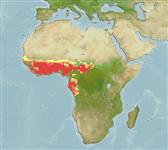Classification / Names
Common names from other countries
Issue
The species Chrysichthys furcatus Günther, 1864 is considered valid in Eschmeyer (CofF ver. Mar. 2012: Ref. 89686). It is treated here a synonym of Chrysichthys nigrodigitatus (Lacepède, 1803) following Risch (1992: Ref. 7324), Risch (2003: Ref. 57126) and Geerinckx et al. (2007: Ref. 81642).
Référence principale
Taille / Poids / Âge
Max length : 65.0 cm SL mâle / non sexé; (Ref. 3236)
Length at first maturity
Lm ?, range 14 - ? cm
Environnement
; eau douce démersal; potamodrome (Ref. 51243); profondeur 3 - ? m (Ref. 13851)
Climat / Gamme
Tropical; 22°C - 28°C (Ref. 12468), preferred ?; 15°N - 13°S, 16°W - 30°E
Distribution
Description synthétique
Épines dorsales (Total): 2; Rayons mous dorsaux (Total): 6; Épines anales 0. Diagnosis: recognized by its pointed snout, the rather small mouth, and the width of the premaxillary tooth plate (1/5-1/3.5, usually 1/4, of head length); vomerine dentition represented by a square to rectangular tooth plate which begins to develop at sizes between 60 and 70 mm standard length; palatine dentition developing at sizes over 100 mm standard length, initially as isolated teeth; second or third branched dorsal-fin ray always the longest; upper caudal-fin lobe much longer than lower lobe; gill rakers long and smooth; other characters, such as length of dorsal fin, number of branched rays in anal fin, and number of gill rakers on first gill arch, are subject to intraspecific variations; sexually mature males and ripe females show considerable morphological differences; such specimens have often been labelled as Chrysichthys furcatus; maturity occurs probably at a rather advanced stage (at over 200 mm SL) and leads to the inflation of head, broadening of mouth and premaxillary tooth plate, shortening of spines and overgrowth of fin-spines by thick skin, the fins becoming more rounded, and the caudal-fin lobes sometimes becoming subequal; the body acquires an emaciated appearance (Ref. 57126).
Statut dans la liste rouge de l'IUCN (Ref. 115185)
Menace pour l'homme
Harmless
Utilisations par l'homme
Pêcheries: intérêt commercial mineur; Aquaculture: commercial; pêche sportive: oui; Aquarium: Aquariums publics
Plus d'informations
CollaborateursImagesStamps, CoinsSonsCiguateraVitesseType de nageSurface branchialeOtolithesCerveauxVision
Outils
Articles particuliers
Télécharger en XML
Sources Internet
Estimates of some properties based on models
Phylogenetic diversity index
PD50 = 0.5000 many relatives (e.g. carps) 0.5 - 2.0 few relatives (e.g. lungfishes)
Niveau trophique
3.2 ±0.41 se; Based on food items.
Résilience
Milieu, temps minimum de doublement de population : 1,4 à 4,4 années (K=0.12-0.65; Fec = 3,086-28,086)
Vulnérabilité
High vulnerability (60 of 100)
Catégorie de prix
